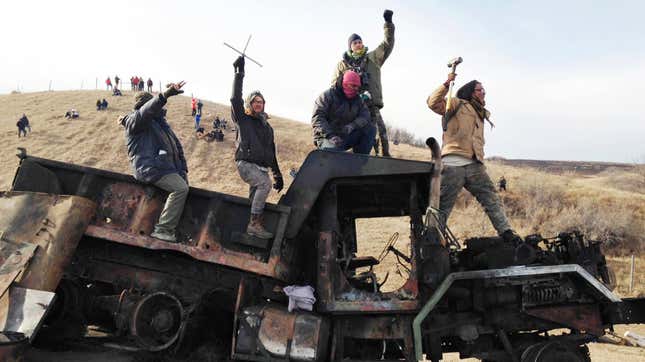
A new report provides new insight into why right-wing legislators all over the U.S. are cracking down on anti-pipeline protests—namely, that the protests really work to limit planet-warming pollution.
Over the past several years, draconian anti-climate protest laws have proliferated across the U.S. In April, the Montana legislature passed one of the most extreme anti-pipeline protest measures in the country, which could impose up to $150,000 in fines and 30 years in prison on anyone convicted of protest-related “vandalism.” Just the month before that, three states passed laws designating oil and gas pipelines and facilities as so-called critical infrastructure, inflicting new penalties on anyone who tampered with them.
These and other anti-protest laws come in the wake of a rising Indigenous movement working to stop fossil fuel extraction and transportation across their land. That movement has scored real victories, too. A new analysis, released last week by Indigenous Environmental Network and Oil Change International, found that Indigenous-led resistance to fossil fuel projects in the U.S. and Canada over the past decade has stopped or delayed an amount of greenhouse gas pollution equivalent to a quarter of annual U.S. and Canadian emissions.
To assess the climate impact of Indigenous resistance to oil and gas infrastructure, the report’s authors examined 21 frontline fights, including major ones like the opposition to the Keystone XL, Dakota Access, and Line 3 pipelines as well as slightly lesser-known movements like the ones against the proposed Rio Grande liquified natural gas export terminal in Texas and the San Juan oil and gas basin in New Mexico. To quantify each protest’s efficacy, the authors calculated the amount of greenhouse gas pollution each project would create, and then tallied up the amount of emissions avoided by victories against projects never completed and delays due to ongoing resistance.
Altogether, these fights have averted the release of 1.6 billion metric tons of carbon dioxide equivalent from entering the atmosphere. That’s about 24% of the total greenhouse gas pollution released by both countries in 2019. Victories in pipeline fights alone resulted in the carbon equivalent of 12% of annual U.S. and Canadian pollution, or 779 million metric tons, not entering the atmosphere.
“The numbers don’t lie,” said Dallas Goldtooth, Keep It In The Ground organizer at Indigenous Environmental Network and author of the report, in an emailed statement. “Indigenous peoples have long led the fight to protect Mother Earth.”
It’s no wonder, then, that the right and fossil fuel interests are so terrified of these protest movements and has thrown resources into criminalizing Indigenous land and water defenders. The report notes that there’s been a ramp-up of repression since the fight against the Dakota Access Pipeline at Standing Rock in 2016. Police, the military, and private security contractors unleashed brutal attacks against water protectors. Some protesters have faced prison sentences of up to 110 years as well.
“What happened in Standing Rock should not be seen as an anomalous incident, but rather a disturbing commonality across Indigenous resistance efforts worldwide,” the report said.
Indeed, in the years since Standing Rock, 36 states have quietly introduced criminal penalties for demonstrating on or near oil and gas infrastructure. Many of them mimic the industry-backed American Legislative Exchange Council’s model bill, which sets out to protect fossil fuel facilities by including them under the legal definition of “critical infrastructure.”
These laws could threaten the immense progress made by protestors, especially because ongoing protest movements are currently holding back 808 million metric tons of carbon dioxide equivalent by delaying projects. Yet just this weekend, Minnesota state troopers arrested some 70 protesters with the group Treaties over Tar Sands at a demonstration outside the governor’s mansion calling on him and the federal government to shut down Enbridge Energy’s Line 3 pipeline, which transports oil from Canada into the U.S. and encroaches on Indigenous lands. Officials in Minnesota are also considering a law to criminalize pipeline protests in the state, which could make the situation even more dangerous.
But of course, as report after major report shows, it’s the Indigenous demonstrators who are on the right side of history. New fossil fuel extraction must end by next year, according to one of those major reports. That one was authored the International Energy Agency, which isn’t exactly known as an environmental justice-minded organization.
“Our climate cannot afford new oil, gas, or coal projects of any kind; phasing out existing fossil fuel infrastructure will already be a monumental challenge,” the report authors wrote. “Indigenous resistance to carbon is both an opportunity and an offering—now is the time to codify the need to keep fossil fuels in the ground, to safeguard both the climate and Indigenous Rights.”